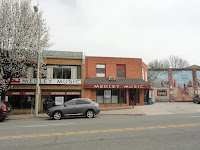 |
| The Chinese Guitar Invasion |
 |
| Beatles on Sullivan 1964 |
This resulted in a guitar boon that lasted for about three or four years. Musical instrument sales of guitars soared, and the majority of those instruments were made in Japan by various manufacturing companies, then shipped in bulk to the United States and Europe where brokers relabeled or ‘badged’ them.
Most of these guitars, basses, organs, and drums were of inferior quality to the American made instruments. The Japanese manufacturers attempted to model the guitars off US made designs. They usually based them on pictures of American guitars since receiving an actual American made guitar was expensive, and had a tariff.
So we not only had The British Invasion of musicians anad bands but we experienced The Japanese Invasion of guitars as well. Though I might add some of these mid 1960’s instruments were also made in Italy, Germany, Czechoslovakia, and Russia.
 |
| Norlin vs Elger 1976 |
Rosenbloom hired two luthiers to build guitars under the Elger brand name.
 |
| Medley Music Bryn Mawr |
The Ibanez company bought Medley Music from Rosenbloom and began using it as their USA distribution center. This resulted in Gibson/Norlin suing Elger for patent infringement. This famous suit was settled out of court, but brought about the term "Lawsuit Guitars". The suit never made it to trial and was settled out of court.
 |
| Orville by Gibson |
 |
| Made In Japan Stratocaster |
Then in 1982 Fender inked a deal with the the FujiGen Gakki factory in Japan to produce some of its guitars. This happened at a time when Fender/CBS was up for sale. Then in 1985 Fender was sold to a group of investors. After the sale Fender did not have an onshore manufacturing site as the Fullerton California site was not part of the deal. Around this date all Fender guitars were made in Japan.
Within a few years there were American made Fenders built in Corona California and the cheaper guitars, basses, amps were built in Eseneda Mexico as well. Later Fender moved it's Squier line are made in China and Indonesia.
With the advent of all the well known USA guitar manufacturers using Chinese, Japanese, and Asian labor to build budget instruments it was bound to result in the same Chinese companies manufacturing their own line of guitars, basses, and amps and retailing those instruments at extremely low costs.
 |
| Yako Musical Instrument Co. |
AXL Musical Instruments also manufactures Squier instruments and is located in Shanghai, China. Squier Affinity guitars are manufactured in China as well as in Indonesia.
 |
| Samick Co. Korea |
 |
| Amazon Electric Guitars |
Interestingly Yako and AXL both build guitars for Gretsch and for Cordoba, which owns Guild Guitar brand. This same company builds guitars under the Donner brand as well.
If you shop on Temu for guitars and basses, these instruments are built by Yako. Fesley Guitars are made by the same Chinese company, Yako. Incidentally, Yako is the same company builds Fender's Squier guitars.
Firefly Guitar are made in China, but by a smaller unidentified company. They are made in small batches. These guitars are of better quality than some of the other Chinese brands and tend to sell out quickly.
These guitars can be found on guitargarden.com.
 |
| Glarry T-Style - $65.99 |
The popularity of Glarry Guitars arises from the very low price point, of sixty to one hundred-sixty dollars for their line up, and most bore resemblance to Fender Instruments.
I purchased a Glarry T-Style guitar. It took me a good while to set it up. The strings that come on the guitar are awful. I was never a fan of Telecaster bridges so it took some work to get all the strings set to a comfortable height. The neck truss rod needed to be tightened up about a quarter turn to the right.. The neck could still use some sanding, since it is rougher than the typical satin finished neck. Also some of the fret ends need to be filed down. After putting all the work into it the guitar is now comfortable to play, however the neck is a little clubby. If you are planning to buy one of these guitars for your kid, I advise that the set up is not a job for a beginner.
 |
| Michael Angelo Batio |
 |
| Sawtooth Guitars |
Sawtooth guitars are made and distributed by the wholesale manufacturer Guangzhou Vines Musical Instrument Company.
They usually sell in lots of a minimum of four pieces direct from the manufacturer. Their house brand is called Smiger Electric Guitars.
 |
| Hotone Nano Amp |
Amazon sells guitars and musical instruments under many different brands, that are generally made at one of the aforementioned factories. Many of these instruments rival Epiphone and Squier guitars and basses.
With some tweaking any these guitars and basses can be updated to very nice instruments.
As I look at the videos below I am reminded of the humble beginnings of Leo Fender's factory in Fullerton California. That facility, Leo Fender opened in 1946, was housed in a warehouse that had little or no ventilation, climate control, humidifiers, air purification, or air conditioning. The current Fender factory in Corona California is much improved, for the guitars, and the employee, The videos below show some of these Chinese factories, but for the CNC machines and other updated equipment, being housed in the same conditions that Fender employees worked in back in the 1950's.
©UniqueGuitar Publications 2024 (text only)
Click on links in the pictures for sources.
Click on links in the text for further information.













